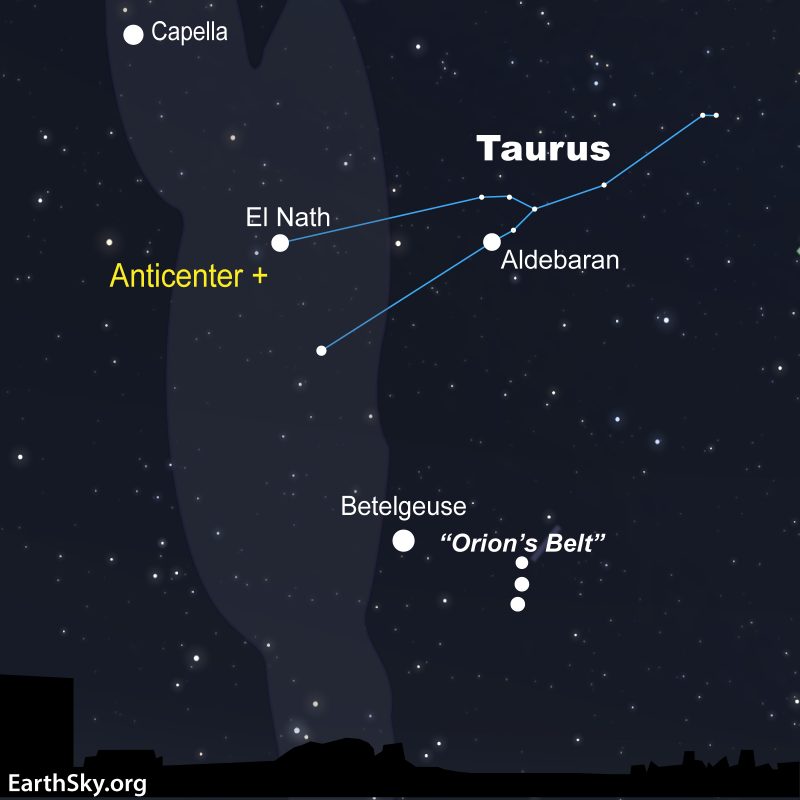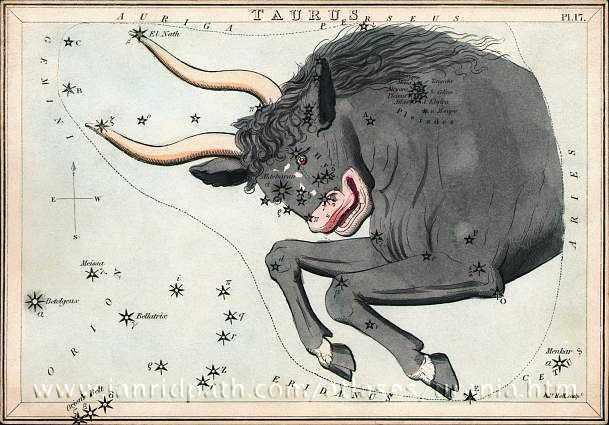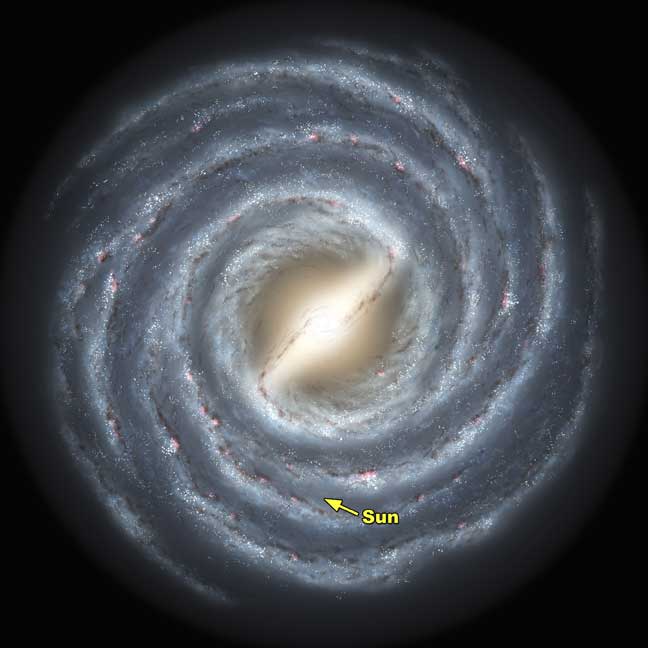
On August evenings, we look toward the center of our Milky Way galaxy. And in January and February, we do the opposite. We look opposite the galaxy’s center, toward the galactic anticenter and the galaxy’s nearest outer edge. The star Elnath (sometimes called Alnath) in the constellation Taurus the Bull is the closest bright star on our sky’s dome to the galactic anticenter.
How to find Elnath, Taurus’ 2nd brightest star
Elnath is easy to find, if you learn to recognize the Face of the Bull in the constellation Taurus. The Face of the Bull in Taurus is shaped like the letter V. The V-shape is fairly easy to pick out from the background stars. These stars are members of the Hyades Cluster. By mid-January, you can find the V-shape nearly overhead about three hours after sunset.
If you extend the right side of the letter V, you come to the star Elnath. Elnath represents the Northern Horn of Taurus the Bull. It also has the name Beta Tauri. It’s the second-brightest star in Taurus after Aldebaran, the reddish star that depicts the Bull’s Eye.
Elnath isn’t quite as bright as Aldebaran. But it’s also part of a noticeable pattern, and it’s blue-white in color.
The 2022 lunar calendars are here. Order yours before they’re gone!

Use Orion to find Taurus and Elnath
Can’t find the Face of the Bull? Try finding Orion the Hunter first, an extremely prominent constellation. You can recognize Orion for its Belt – a short, straight row of three medium-bright stars.
Draw a line upward through Orion’s Belt to find Aldebaran and the V-shape group of stars outlining the Bull’s Face. Extend the lines off the top of the V to locate the two stars marking the tips of the Bull’s horns. The northern and brighter horn star is Elnath.

When and where to look for Elnath
In the Northern Hemisphere, we see Taurus and its stars on winter evenings. Elnath stands opposite the sun around mid-December and thus rises around sunset and sets around sunrise. In January and February, Elnath is already up in the southeast at sunset. By June, Elnath will be lost to the sun’s glare and won’t be seen at all. Excepting June, however, Elnath can be seen for at least part of the night throughout the year.
Elnath stands a bit north of the ecliptic, the annual pathway of the sun in front of the background stars. Because the moon’s path is always near the ecliptic, the moon swings close to Elnath every month. Generally, the moon swings to the south of Elnath. On occasion, the moon swings far enough north that it occults – passes directly in front of – Elnath. The next time this happens is September 7, 2023. That occultation marks the first of a series of monthly occultations that will last until April 11, 2027.

How to locate the Milky Way’s anticenter
The galactic anticenter lies about 3 degrees to the east of the star Elnath. Three degrees is about the amount of sky that your thumb covers when held at arm’s length. The galactic anticenter isn’t a place, it’s just a direction in the sky. Elnath is about 130 light-years away, whereas the outskirts of our galaxy’s disk are many thousands of light-years away. So Elnath is much closer and just shows the direction.
While the closest bright star to the galactic anticenter is Elnath in Taurus, the anticenter isn’t in Taurus. Instead, it lies in a neighboring constellation, Auriga the Charioteer.

Science of the star Elnath
Elnath sparkles white and is tinged in blue. This star’s color indicates that it has a hot surface temperature of about 13,600 Kelvin (13,300 Celsius or 24,000 Fahrenheit). Contrast this to the surface temperature of our yellow-colored sun, which is 5800 Kelvin (5,000 C or 10,000 F).
According to the star expert Jim Kaler, Elnath has 4.5 times the sun’s mass and shines with the firepower of 700 suns.
Elnath’s position is RA: 5h 26m 17.5s, dec: +28° 36′ 27″

Bottom line: Elnath is the second-brightest star in the constellation Taurus the Bull. It marks the Northern Horn of the Bull and lies just 3 degrees from the galactic anticenter in our sky. Elnath is larger than our sun and shines blue-white in color.
The post Elnath is close to the galactic anticenter first appeared on EarthSky.
from EarthSky https://ift.tt/3GMoZQN

On August evenings, we look toward the center of our Milky Way galaxy. And in January and February, we do the opposite. We look opposite the galaxy’s center, toward the galactic anticenter and the galaxy’s nearest outer edge. The star Elnath (sometimes called Alnath) in the constellation Taurus the Bull is the closest bright star on our sky’s dome to the galactic anticenter.
How to find Elnath, Taurus’ 2nd brightest star
Elnath is easy to find, if you learn to recognize the Face of the Bull in the constellation Taurus. The Face of the Bull in Taurus is shaped like the letter V. The V-shape is fairly easy to pick out from the background stars. These stars are members of the Hyades Cluster. By mid-January, you can find the V-shape nearly overhead about three hours after sunset.
If you extend the right side of the letter V, you come to the star Elnath. Elnath represents the Northern Horn of Taurus the Bull. It also has the name Beta Tauri. It’s the second-brightest star in Taurus after Aldebaran, the reddish star that depicts the Bull’s Eye.
Elnath isn’t quite as bright as Aldebaran. But it’s also part of a noticeable pattern, and it’s blue-white in color.
The 2022 lunar calendars are here. Order yours before they’re gone!

Use Orion to find Taurus and Elnath
Can’t find the Face of the Bull? Try finding Orion the Hunter first, an extremely prominent constellation. You can recognize Orion for its Belt – a short, straight row of three medium-bright stars.
Draw a line upward through Orion’s Belt to find Aldebaran and the V-shape group of stars outlining the Bull’s Face. Extend the lines off the top of the V to locate the two stars marking the tips of the Bull’s horns. The northern and brighter horn star is Elnath.

When and where to look for Elnath
In the Northern Hemisphere, we see Taurus and its stars on winter evenings. Elnath stands opposite the sun around mid-December and thus rises around sunset and sets around sunrise. In January and February, Elnath is already up in the southeast at sunset. By June, Elnath will be lost to the sun’s glare and won’t be seen at all. Excepting June, however, Elnath can be seen for at least part of the night throughout the year.
Elnath stands a bit north of the ecliptic, the annual pathway of the sun in front of the background stars. Because the moon’s path is always near the ecliptic, the moon swings close to Elnath every month. Generally, the moon swings to the south of Elnath. On occasion, the moon swings far enough north that it occults – passes directly in front of – Elnath. The next time this happens is September 7, 2023. That occultation marks the first of a series of monthly occultations that will last until April 11, 2027.

How to locate the Milky Way’s anticenter
The galactic anticenter lies about 3 degrees to the east of the star Elnath. Three degrees is about the amount of sky that your thumb covers when held at arm’s length. The galactic anticenter isn’t a place, it’s just a direction in the sky. Elnath is about 130 light-years away, whereas the outskirts of our galaxy’s disk are many thousands of light-years away. So Elnath is much closer and just shows the direction.
While the closest bright star to the galactic anticenter is Elnath in Taurus, the anticenter isn’t in Taurus. Instead, it lies in a neighboring constellation, Auriga the Charioteer.

Science of the star Elnath
Elnath sparkles white and is tinged in blue. This star’s color indicates that it has a hot surface temperature of about 13,600 Kelvin (13,300 Celsius or 24,000 Fahrenheit). Contrast this to the surface temperature of our yellow-colored sun, which is 5800 Kelvin (5,000 C or 10,000 F).
According to the star expert Jim Kaler, Elnath has 4.5 times the sun’s mass and shines with the firepower of 700 suns.
Elnath’s position is RA: 5h 26m 17.5s, dec: +28° 36′ 27″

Bottom line: Elnath is the second-brightest star in the constellation Taurus the Bull. It marks the Northern Horn of the Bull and lies just 3 degrees from the galactic anticenter in our sky. Elnath is larger than our sun and shines blue-white in color.
The post Elnath is close to the galactic anticenter first appeared on EarthSky.
from EarthSky https://ift.tt/3GMoZQN

Aucun commentaire:
Enregistrer un commentaire